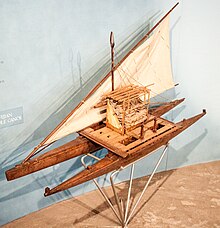

Drua, also known as na drua, n'drua, ndrua or waqa tabu ("sacred canoe", Fijian pronunciation: [waᵑɡa taᵐbu]), is a double-hull sailing boat that originated in the south-western Pacific islands. Druas do not tack but rather shunt (stern becomes the bow and vice versa). Both ends of each hull are identical, but the hulls are of different sizes and the smaller one is always sailed to windward. The main differences, compared to proas, are that the hulls have a symmetric U-form profile, and a second hull is used instead of an outrigger. When a float (cama) is used in place of the smaller hull, the craft is called a camakau.
The Fijian double canoe (wangga ndrua, spelt waqa drua in Fijian) was the largest and finest sea-going vessel ever designed and built by natives of Oceania before contact with Europeans.
- — Canoes of Oceania Volume I: The Canoes of Polynesia, Fiji, and Micronesia (1936)[1]
Druas were large, up to 30 metres (98 ft) long, and could carry more than 200 people. Despite being called "canoes", they were not dugouts, but plank-built ships.
- ^ Haddon, A.C.; Hornell, J. (1936). Canoes of Oceania Volume I: The Canoes of Polynesia, Fiji, and Micronesia. Honolulu, Hawaii: Bishop Museum Press.